Veering away from my usual review format a little for this one, as I have the second edition published by Z-Man. The game has been updated since then, which, believe me, makes a big difference in one particular area. It’s also pre-used and came with slightly different, I wouldn’t say upgraded, components, which are useable but did prove a bit of a hindrance.
So, missing a few things out, here we go…
The Facts
Want to get straight to my thoughts? Then feel free to explore, and uncover, ‘So, what do I think?’
- Designer: Ignacy Trewiczek
- Publisher: My version is from Z-Man games
- Year Released: Originally 2012
- Players: 1-4
- Playing Time: 60-120 minutes
- Ages: 14+
- Recommended Retail Price: £54.99
Core Principles
A brief look at the main game aspects.
Robinson Crusoe is a co-operative worker placement game that also involves resource management.
There are 4-characters to choose from – Carpenter, Cook, Explorer, Soldier – each possessing 4 unique skills. The skills are activated by collecting and using determination, which can be gained in several ways throughout the game, such as Morale, and Arranging the camp.
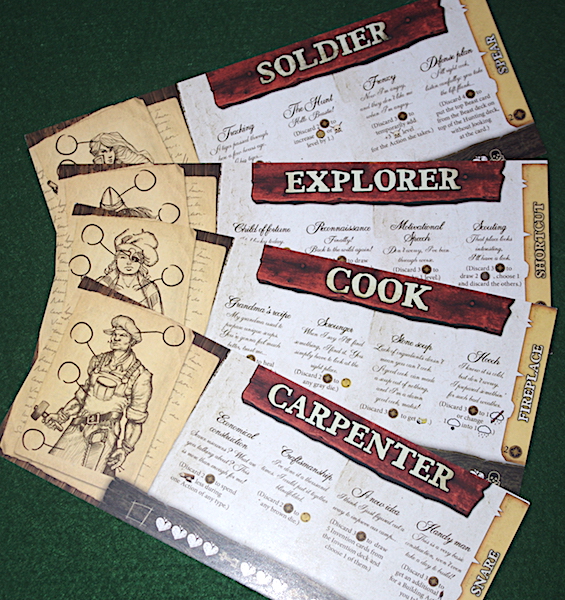
6 Scenarios are available, which can be played independently, there is no campaign mode. Each scenario plays quite differently from the rest and present their own unique challenges.
A game round consists of 6 phases.
- Event Phase – A card is drawn from the event deck and its effects applied. The card is then placed in the threat area where any other cards are moved to the left. If two cards are already in the threat area the left most is removed from the game and its threat effect resolved.
- Morale Phase – The first player gains/losses determination tokens dependent on where the Morale token is.
- Production Phase – Resources are gained from the tile where camp has been made, usually in the form of wood and food. These are immediately available.
- Action Phase – Players place their pawns and any required resources on the actions they wish to take. Most actions can be taken more than once in a round. Some actions can have a second pawn placed to support another on that action, which guarantees a success, otherwise action dice may have to be rolled to decide the outcome of the action. If two pawns are placed by different characters one must be assigned as the resolving character and any effects will apply to that character, the other is the supporting character. The actions are resolved once all pawns are placed.
- Threat Action – The event cards within the threat Action area will indicate the number of pawns and resources needed to resolve the card. Once resolved the instructions are followed and the card removed from the game.
- Hunt – This action requires two pawns assigned to it and there must be cards in the Hunt deck. The top card is revealed, and its effects resolved. The Beasts strength will be compared to the players weapon level and if greater the character takes the difference in wounds. Other effects involve damage to weapons (decrease in level) and the gaining of resources, notably food and fur.
- Build – There are a number of things that can be built – Shelter, roof, palisade, weapons level, inventions, etc. – with the pawns and any required resources being placed in the relevant positions. A single pawn will require a roll of the Build action dice (see below).
- Gather – Pawns can be assigned to tiles adjacent to that of the camp to gather the tile’s resources. It is possible to gather resources from further afield, but more pawns will be required to do so. Once gained, resources are placed in the future resources area. A single pawn will require a roll of the Gather action dice (see below)
- Explore – Pawns can be placed in unexplored locations adjacent to at least one explored tile. If the action is successful a new tile is revealed. Revealing the tile may lead to a number of things happening; beasts being discovered – place the top beast card in the hunt area, discovery tokens gained, which are placed in the future resources area, scenario effects may apply – consult the scenario sheet, and terrain type will be indicated. A single pawn on this action will require the roll of the Explore dice to determine success (see below).
- Arrange Camp – For each pawn placed here the character gains determination and/or, dependent on number of players, raises morale by 1.
- Rest – For each pawn placed here the character heals one wound.
- At the end of the action phase future resources, including discovery tokens and treasures, are made available; Inventions in the future resources area are resolved and their cards flipped, they are now available
- Weather Phase – The round number on the scenario sheet will indicate which weather dice to roll, if any. There are three weather dice – Rain, Winter, and Hungry animals. This could result in discarding wood, food, damage to the palisade, combat against hungry animals, and taking wounds; it all comes down to how well you’ve built up your camp!
- Night Phase – During this phase characters can use discovery tokens and treasures to heal their wounds. They must also eat, discarding one food per character or suffer wounds. The camp can be moved to an adjacent tile, but this will affect your current roof and palisade level. If you have no shelter built, then the characters take a wound for sleeping under an open sky. Perishable food must be discarded unless you have the means to store it. The scenario round marker is advanced and the first player token passed on to the next player.
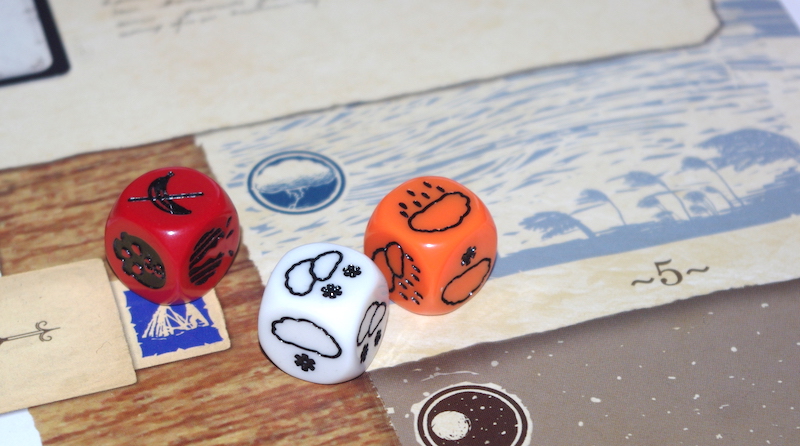
The above is a quick rundown of a game turn, but the following is worth a mention too…
Action Dice – The Build, Gather, and Explore actions require a roll of their respective dice if only one pawn is placed on the action. Each action has three dice: Wound die, the character may suffer a wound attempting the action; Success die, the character succeeds or fails, a failure grants two determination tokens; Adventure die, the character experiences an adventure whilst carrying out the action and draws an appropriate card to resolve.

Mystery Deck – When told to do so cards are drawn from the Mystery deck. The deck contains Traps, Treasures, and Creatures. A card may tell you to draw 2 mystery cards, resolve 1 trap and 1 treasure. In this case you draw cards from the deck until either a trap or treasure card is drawn, you then resolve that card. You then have the option to continue drawing cards until the other option is drawn, at which point you resolve that too.

So, what do I think?
Components
As my game was second-hand and an older version, I’m going to pass on talking about the components as I can’t guarantee that the latest version by Portal Games is the same.
Theme
If you’re worried about how you’d cope if ever washed up on some deserted Island, then play this game, it’ll set you in good stead. It throws problems at you like there’s no tomorrow and, if you don’t get things right, there probably won’t be! All these problems just ooze theme.
The character skills are appropriate to their background, such as the Cook being able to rustle up a meal from out of nowhere, or the Explorer being able to recce the area; the fact that these skills are driven by determination just feels right too.
All the actions available make sense too. Everything is linked to something within the theme – Building, Hunting, Gathering supplies, and so on – but it’s the way you have to put them together that hits the nail right on the head. Want to improve the roof over your head? No problem, but you’ll need an animal skin or two and a bit of wood to build it. So, I’ll have to go and hunt something to get fur, but what, I haven’t come across any animals worth the effort yet. Okay, if I go exploring, I might come across something, and I do, look prints, but what could it be?
Hang on, those prints look a bit on the large side, and I don’t have any weapons, best I build something to protect myself, what about a spear?

Hopefully, you get the idea. It’s all well thought out and play is immersive, even the weather plays a part, usually to your annoyance, and you’ll have to keep your Morale up, as a happy survivor is a determined one!
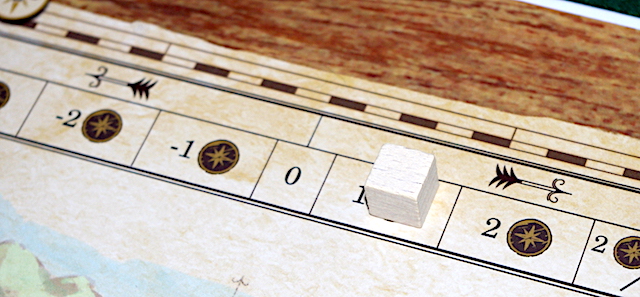
The game’s mechanisms drive the story and create the atmosphere. It really conveys the desperation and struggle that I can only imagine comes with being stranded on desert island.
Rules
The rules in the Z-man edition aren’t great, in fact they’re pretty dire indeed, but do not fret, they’ve been updated in the later versions and now they’re… well, an improvement, but not particularly great either.
It’s a worker placement game. you place a worker, you take an action, how complicated can it be?
The problem is to do with the flow of the rules. It should be as simple as; here’s the build action, put your pawns here and do this, this, or this. But no. There’s an overview section, giving a quick insight into the phases. Then it goes through the phases in a little more in depth and it’s here that a short story has been cut long. When you get to the meaty phase of actions, it starts by giving you a brief explanation of each action. Then it goes through how to assign pawns and resources for each action. A little bit on resolving actions follows and finally, an explanation on exactly what they do and how to fully resolve them, it’s a long-winded way of doing it in my eyes and leads to a lot of flicking back and fore.
I would rather have seen each action listed only once, with a full explanation of how to place the pawns and its resolution all in one place.
There was one point I found particularly confusing, and that was how to draw Mystery cards. When a card says draw ‘1’ Mystery card and only resolve treasure, it doesn’t mean just draw ‘1’ card and if it’s a treasure then resolve it. You draw cards until you get a treasure card and resolve it. Confused?
How about: draw ‘2’ Mystery cards and only resolve ‘1’ trap and ‘1’ treasure. So, you draw cards until either a treasure card or a trap comes up, you then resolve that card, say it’s the trap. Now you have the choice to continue drawing cards, but as you know you only had to resolve ‘1’ trap you can keep going until a treasure card comes up.

I kept forgetting how this worked and had to keep referring to the rules; it’s the way it is written on the cards and I think it would have been better worded, ‘Draw Mystery cards and resolve 1 trap and/or 1 treasure.’
The rule book stretches on for 40 odd pages with the appendix being the most welcome and laid out part.
Gameplay
Note: I’ve only ever played this solo and when doing so I tend towards using multiple characters rather than playing the specific solo rules mentioned in the book, which I played but didn’t enjoy as much, and so I will only be covering the game from that perspective.
Setup was straightforward enough, at least it was once I’d been through the process once or twice, and I had a couple of choices to make – characters and scenario.
In my version there were four characters to choose from, each with their own unique skills that require determination tokens to use. The characters, Cook, Explorer, Soldier, and Carpenter, each brought something different to the game and, as with everything else, they took a little thought to get the best from. Building up determination was part of it, but timing was another, especially if I only had enough tokens at hand to use one skill.
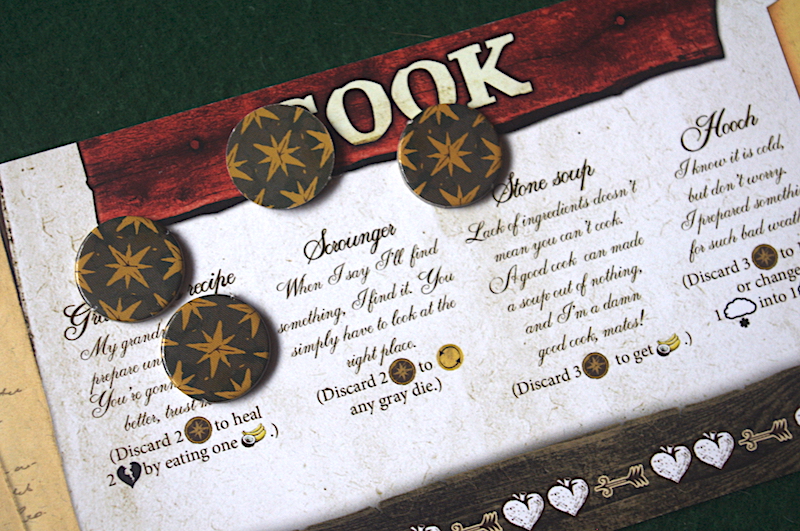
I often found myself using a skill only to regret it moments later. For example: I’d use the Soldiers ‘The Hunt’ to increase my weapon level, only to find that the beast I was hunting was bigger than expected and that ‘Frenzy’ would have been more use, temporarily raising my weapon by 3 for the action. With experience I did gain an insight into what to use and when, but it could still go drastically wrong!
This made the skills both thematic and an integral part of the game, as determination played an important part – we’ll be coming back to that a little later. Trying to decide if, and when to use the skills occasionally slowed the game down with indecision, not too much of a problem when playing solo, though I would imagine it could be when playing with others.
The scenarios are varied considering they all centre on you being stranded on a deserted island and a good job had been done to make them all play quite differently. The scenarios could be played in any order, they aren’t linked (pity there isn’t a campaign) but starting with scenario 1 and working through is recommended. The first one was difficult, and it only got harder from there!
Once character and scenario choice had been decided, I could dive into the game and straight away realised that, whilst this is at heart a worker placement game, it one that’s all about priorities.
Let’s take the first scenario as an example – Castaways. The main goal of the scenario is to invent ‘Fire’ and build a large pile of wood to provide a beacon for passing ships. The scenario description, though, suggested that I may want to prepare for winter by building a shelter with a roof and palisade.

Armed with this information a new player would inevitably take a, ‘Suck it and see’ approach and that’s probably the best thing to do in the first game or two, as they’d quickly learn what’s really important and what’s just important. Also, with a few games under the belt one soon realises the method to use in approaching this game, and that’s logic.
This was the game’s biggest appeal to me, that you can, more or less, think your way through every round of the game, it then came down to the random things thrown at me by the event, hunt, and adventure decks, as to whether things went my way or not, and I had to be prepared to mitigate their effects.
So, in Castaways you know the goal, but how to get there? Taking what you’ve probably learnt in losing your first couple of games, mainly the importance of having shelter and being able to eat, you’ll be able to prioritise your aims. This sets you up with a path to take – do this, then this, and hopefully at that point you can do this to win the game – or roughly translated into, find food, build shelter, invent fire, and build a beacon. Of course, though, it isn’t all as easy as it sounds.
As you explore the Island your options open up, enabling you to gather resources from neighbouring tiles to your camp. You’ll also get to draw Discovery tokens, which are a boon, and some of these have different affects depending on scenario. Deciding when to use them is yet another decision you’ll have to consider.
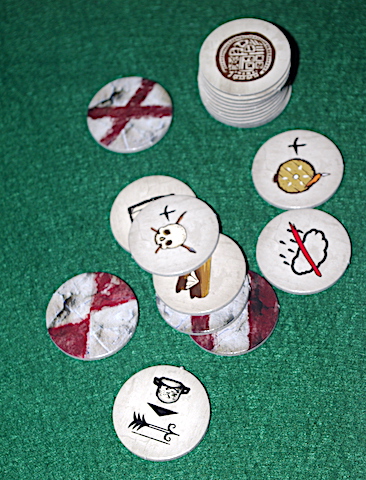
Food, in itself, is a problem that needs unravelling. For instance, you may have a load of it in your available resource box, but is it perishable? Yes? Oh, dear, it isn’t going to last until next turn unless you’ve figured out some way to store it. Non-perishable food is much more welcome, best of luck in working that one out!

Building a shelter, are we? Well, you’ll need wood, not too much of an issue (but of course you’re tempted to keep it for the beacon, aren’t you?), and you’ll also need fur, which you can get from hunting. To hunt you’ll first have to find traces of animals – in other words you’ll need beast cards in your hunting area – you’ll also need to raise that weapons level just in case the beast turns out to be bigger than you expected. Raising the weapons level will, more often than not, require more wood – running short now, are we? There are more ways to do it, inventions, skills, and such like, you’ll soon figure it out, your life depends on it!

So, of you go exploring, hoping to come across animals to hunt and, with a bit of luck, other goodies to use… and the game goes on.
As you can see from this brief overview, that just to achieve something as basic as building a shelter requires numerous other things to take place first – so many things intertwine and there is more than one way to skin a cat, so you never feel as if something is impossible, though you might feel a little dumb having not yet figured it out.

Every decision is risk/reward driven and one of the biggest decisions you make each turn is how many pawns to commit to each action. Placing two pawns on an action, whether two from the same character or one each from two different ones will guarantee a successful action – think of it either as one character taking lots of time or two characters helping each other out. Placing only one, though, will put your chances of success in the arms of the action dice.
Three dice are rolled; one to see if you take any wounds, another to see if an adventure card is drawn, and finally, one to see if you succeed or fail. Failure grants you two determination tokens. Providing you’re relatively healthy the worst that can happen here is failure (…or is it?), as it means you’ll have to wait another turn to try and achieve what you wanted.

Failure gets you determination, so committing one pawn to an action that isn’t vital for that turn can set you up for the future, as the more determined you are the more skills you’ll be able to use, though each skill can only be used once per round – just another thing to consider!
The adventure cards add greatly to the story, but again they usually have some risk/reward to them. Many give you a boon, but if you take it, the card gets shuffled into the event deck and will come back to bite – best remember and prepare. Others work the opposite way and lumber you with a negative effect that will be negated when the card gets drawn from the event deck. There are other ways adventure cards work too, but I’m not going to spoil that surprise.
Deciding on the number of pawns to commit is a juicy part of the game. If you try to get instant successes for each action then you’ll soon realise you can’t achieve everything you need, so again it comes down to prioritising – what do I really need this turn and what could slip by at a pinch.
With really only three resources to consider – wood, food, fur – you’d think things would be simpler than they are but gaining resources and spending them is finely balanced. You have to pay each their due and spend one to make gains in another when you need to, however that may be, don’t be shy!
Well, that’s my take on the main aspects of the gameplay, but here’s a quick rundown of some of the things I really liked.
The way the theme was driven through the mechanisms was superb and completely absorbing. Everything made sense and that helped to take a logical approach to the game, by considering what I’d do if really stranded on an island.

Every choice I made had repercussions, whether choosing to use determination for a skill or using two pawns to succeed in an action, and whilst it could lead to a bit of analysis paralysis, as a solo player I just loved being faced with these types of problem.
The game was difficult, but it never felt impossible. Every time I lost, and I lost many, many times, I could pin-point it down to when and why it all went wrong.
There was plenty of randomness in the game – the event, hunt and adventure decks, the action dice, and the weather dice – but on the whole it could be mitigated with planning, and whilst I’m not a fan of too much randomness in a game I did like it here as it lent itself to the theme.
The threat area. I like the way that events pushed others along and finally out of the threat area. It gave me yet another thing to think about, but I could see the consequences of letting it ride and make a decision of when, or if, I’d deal with it. Sometimes it just wasn’t worth wasting an action, but if it was, then you had time to prepare to do something about it.
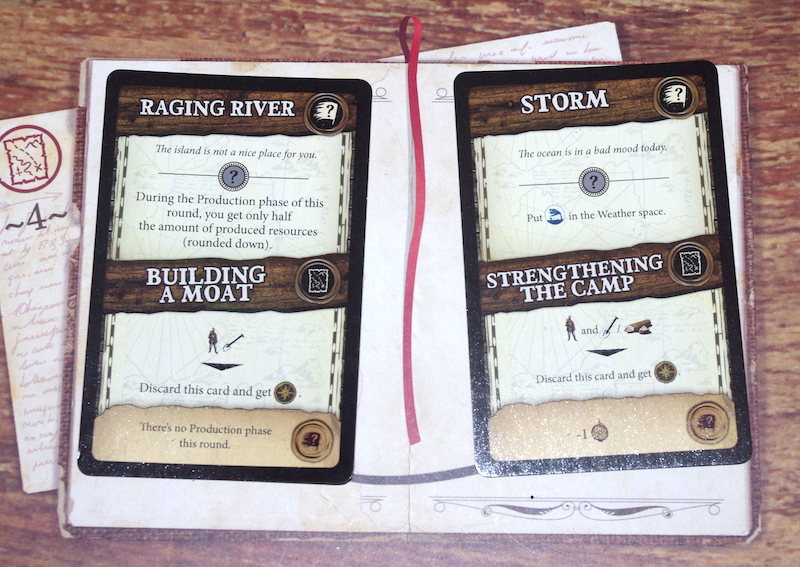
The way that inventions linked together, and was visible at a glance at the cards, gave yet another aspect to planning. For example: A glance at the board told me that to invent a knife I need to have found mountains (just the right type of rock for a knife). Once I’d discovered them a token was placed on the symbol of the knife, so I knew I could invent it. But I also had the spear card out on the board, which I could see needed the knife and some wood. So, I could plan what would be the most useful things to build – decisions, decisions!

Balance and scaling
Playing solo, I used 3-characters rather than 4, otherwise I found it became all too easy to suffer from information overload with just too many decisions to make, and it became a bit of a grind rather than fun. This is probably why the included solo rules introduce Friday and the dog rather than simply using multiple characters like I do.
Playing 2-characters introduces Friday, and pure solo adds the dog too. I only played this way once and didn’t enjoy it as much – don’t get me wrong, it works and is okay, I just preferred to use multiple characters.
In terms of balance, the game is difficult, but as I mentioned, I always felt the game was beatable and that it was my inept play that was holding me back. The rules do state that the Soldier is of less use in a 2-player game, but I had no issues playing 3 or 4, in fact I would say that all characters had an important part to play, it just takes time to figure out what that is.
There are ways to make the game easier and amazingly, harder too. I haven’t used any of these rules. I wouldn’t be happy unless I beat it on the standard setting and after a couple of run throughs you get the feeling you’re just a decision or two away from doing just that – that’s how the game makes you feel… but it lies!
Making it harder, well, if I ever get to the point I need to do that, then I’ll announce it from a great height through a very loud speaker!
The game also scales for player count by increasing the number of resources required to build a shelter/roof/palisade and in a 4-player game the ‘arrange camp’ action gives you a choice between increasing morale or gaining 2-determination rather than both.
Replayability
Perseverance is the key. The rules may put a downer on your first experiences and there is an amount of ‘fiddliness’ about the game – so much going on and each decision leads down a path you need to consider – but once you’ve got the mechanisms nailed the game flows through the phases nicely and allows you to spend more time thinking about how to achieve your goals rather than how to place your pawns!
The game rewards repeat play, as you learn what to, and what not to do by experimenting and finding your way. The 6 included scenarios will keep you invested for many hours to come – I just couldn’t move on until I’d beaten the current scenario.
The randomness generated by the decks also gives the game longevity, as playing the same scenario over and over doesn’t get repetitive. Even if you played through using the same event deck the other things going on would make it feel a different game.
Recommended?
Throw away that 300-year-old, Daniel Defoe, 1st edition you have tucked away in a vault, play the game instead.
Robinson Crusoe is a juicy game to play, there are a lot of things to consider and plan for, and on first encountering it may come across as a little fiddly. This is mainly down to the rules, which could put some people off, as you’ll be diving in pretty regularly whilst learning to play; I didn’t find them particularly user-friendly – wordy springs to mind!
But, and it is a big but, it’s most definitely worth the effort.
If you like a challenge this is the game for you, just persevere through the initial games and it all opens up in front of you. You’ll gain an insight into things like, how to preserve food, and just how long it takes to build a roof!
It is a worker placement game with tight resource control, but you’re not competing to place your pawns, in this one you’re co-operating, which makes a nice change. But of course, there are never enough pawns to do everything you want and so you must prioritise, and that, for me, is the heart of this game.
A solo player who relishes thinking ahead, planning things out, and taking their time over each round will love this, I do!
Conversely, though, this isn’t going to be to everyone’s taste. The game is quite complex (Medium Heavy on BGG) especially in terms of planning ahead and I wouldn’t bring this game out for a little light entertainment. It isn’t fast paced either and time will be spent on considering your actions for the round, though solo this isn’t really an issue.
There are plenty of random elements, which might not be to everyone’s liking, though personally I feel they play to strengthen the theme – it’s almost like playing a sadistic desert island simulation game!
The difficulty of the game is pitched so that when you do win you feel a great deal of satisfaction and is really quite rewarding.
Finally, completed everything in the box? Well, there are plenty of expansions to be had, so if you could only take one game with you on your own desert island, this one wouldn’t be a bad choice at all.
My experiences
Players: 1-4. I’ve only ever played solo, but I have used a range of characters and would say that 3 is the sweet spot with 4 not far behind. I wasn’t a fan of using Friday or the Dog in the 2-player or solo made as per the rules. I found playing the extra characters instead far more rewarding and fun.
Playing time: It’s advertised as 60-120minutes, but the majority of my games came in at 120+. playing solo I may be more prone to taking my time to think through rounds; I’m also not the fastest player in the world anyway, so take that into account!
Age: 12+. If they can handle the complexity let them play, there’s a lot that could be learnt from playing this game – prioritising, logic, risk/reward, etc.
Expect to pay: £42 on Chaos Cards.
Read my thoughts one year on – HERE
Extras
Official site – Portal Games
Recommended video review – The Dice Tower (This is the version I have.)
Want to learn the rules? – How to play, by Watch it Played
BoardGameGeek page – HERE

Justin,
I really enjoyed reading your adventures in a deserted desert island!.
I purchased the original printing not too long after launch and was stoked to get playing.
The whole Robinson Crusoe theme is like a moth to a flame for me, so I was very excited…….until I hit the horrible rule book.
I struggled with it and gathered the ( at the time) limited information available on Bgg.
Donna and myself sat down to play and promptly got a right good spanking from the island.
After all the effort to get it to the table , the clunkiness ( mainly rules not mechanics ) , that was it for me and Robinson Crusoe.
I promptly sold it.
For a few years now I have thought about repurchasing the game again ( I much prefer the original box shape and art – the one you shine here).
I think (hope) that I have since evolved as a gamer and could now take on this beast . I’m happy to print out latest rules and feel confident I will have tackled even worse rule books over the years.
Justin, your write up gas inspired me and I will make it my first purchase of 2021.
I do have to sell some titles first!.
On a side note:
Donna and myself are really enjoying Uwe Rosenbergs new big box game “Hallertau”. Plays 1-4 out the box and I can see the solo game bring just as good. ( over 300 cards for diversity).
Check it out and have a great Christmas 🙂
LikeLiked by 2 people
Thanks Mark.
Yeah, the original rules are, putting it mildly, bad, but there are plenty of videos out there now that do a good job of talking you through the basics.
The newer rules are slightly better, but very wordy and I ended up flicking back and fore as I played.
Once you have the rules pat, though, then the game shines through, but boy, is it a challenge.
I agree, the original box shape and artwork are much more esthetically pleasing than the current version.
I’ll check out Hallertau, thanks, I’ve taken a shine to Rosenberg’s games of late.
You and your family have a great Christmas too 🎅
LikeLiked by 1 person
Great write up. This game has been on my wishlist for quite awhile. I used to have Imperial Settlers, also by Ignacy Trewiczek, but I had a similar situation with that one where some of the rules/cards didn’t make
much sense as written. I really wanted to like that game, but found other games I enjoyed more (so it goes). I think I might be better off playing Crusoe one time with a group who knows it, before buying it. Or maybe watching a video like you recommended.
LikeLiked by 2 people
Thanks Faust.
It’s a shame that bad rules can ruin a damn fine game.
My biggest issue is that I tend to play games in fads, so once I’ve put it away it’ll be another 6 months+ before it comes out again, at which point I have to go through the learning process again because I have the memory of a goldfish.
If I didn’t know how good the game was I’d probably have ditched it by now, but it scratches that itch of a being a co-op that’s challenging and thematic.
Would definitely recommend play before you pay.
LikeLiked by 2 people
I’m the same way. Before COVID I was part of a boardgame group, and sometimes would be called on to teach a game. With so many games in my collection, I need the rules to be intuitive as possible, otherwise I’ll forget. Nothing worse than looking up rules, referencing BGG, when you have some grumbly player in you’re group! There are so many good games out there now though, that it’s easy to be more selective.
With Crusoe, I’ve read a few articles and comments on it…and it really seems right up my alley. I’m a fan of survival scenarios and punishing permadeath Roguelikes. So I know I will be compelled to give it a go at some point!
LikeLiked by 1 person
Sounds like you enjoy the challenges this game presents! 🙂 I enjoyed reading though it all!
LikeLiked by 1 person
Thanks john.
Yes, though sometimes it’s a bit like poking yourself in the eye for enjoyment, what with those rules!
LikeLiked by 1 person